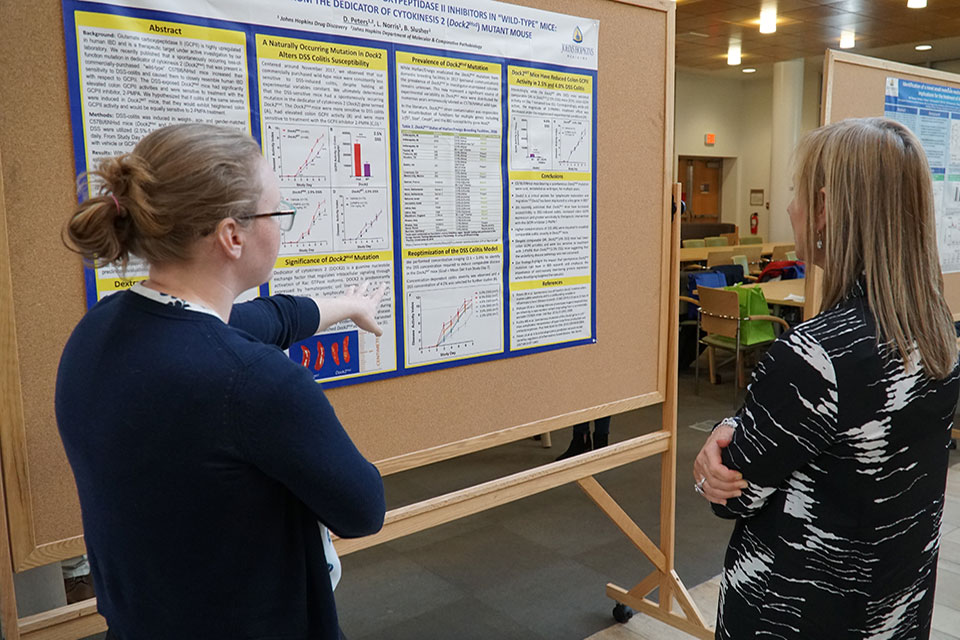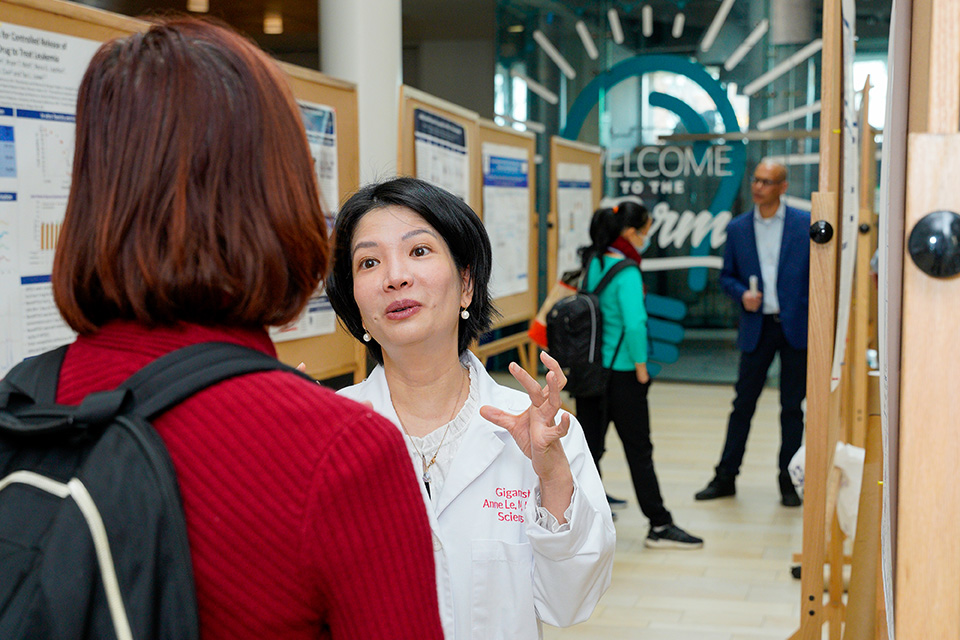Symposium Brings Together Drug Discovery Experts from School of Pharmacy, Johns Hopkins
Biennial event facilitates scientific exchange and interactive communication among students, postdoctoral fellows, and faculty from two of Baltimore’s premier academic institutions.

By Malissa Carroll
January 8, 2020
The University of Maryland School of Pharmacy welcomed nearly 200 researchers from across the University of Maryland, Baltimore (UMB) and Johns Hopkins University (JHU) to the second UMB-JHU Joint Symposium on Drug Discovery on Dec. 3. Organized by Paul Shapiro, PhD, professor and chair of the Department of Pharmaceutical Sciences (PSC) at the School of Pharmacy, and Barbara Slusher, MAS, PhD, professor of neurology at the Johns Hopkins University School of Medicine and director of Johns Hopkins Drug Discovery, the symposium provided an open forum for scientific exchange and interactive communication among students, postdoctoral fellows, and faculty from two of Baltimore’s preeminent academic institutions.
“When we hosted the first UMB-JHU Joint Symposium on Drug Discovery in 2017, we knew the potential existed for us to expand collaborative research among investigators at our institutions,” says Shapiro. “However, we could not have predicted just how tremendous the impact would be in bringing together researchers to collaborate on a variety of new projects aimed at advancing the field of drug discovery. The past two years have witnessed an exponential increase in research collaborations between our universities, and we hope that this year’s event will not only build on those existing relationships, but also explore other areas in which untapped potential for collaboration might still exist.”
A Critical Collaboration to Advance Drug Discovery
The symposium was divided into two sessions. Craig Hendrix, MD, professor of medicine and pharmacology and molecular sciences at the Johns Hopkins University School of Medicine, kicked off the event with a presentation that offered a comprehensive overview of the Institute for Clinical & Translational Research (ICTR) Drug Discovery and Development (D3) Program, a pivotal collaboration between UMB and JHU spearheaded by Hendrix, Slusher, and James Polli, PhD, the Shangraw/Noxell Endowed Chair in Industrial Pharmacy and Pharmaceutics at the School of Pharmacy.
“The ICTR D3 Program marks a truly exciting collaboration between UMB and JHU,” said Hendrix. “Our overarching goal is to provide conceptual, consultative, and technical support to translational scientists within UMB and JHU, as well as to those at other research institutions, to help them navigate the complex drug development process. Everyone who is a part of this collaboration feels energized by the work that we are undertaking. We are bringing together some of the best parts of both UMB and JHU, pooling our collective expertise and resources in this field and using this combined knowledge to assist others in advancing drug discovery across the region.”
The ICTR D3 Program features 12 drug discovery cores focused on the areas of drug discovery and early drug development, pharmaceutics and regulatory issues, clinical development, and analytical issues. Following Hendrix’s presentation, faculty from four of the cores – including Alexander MacKerell, PhD, the Grollman-Glick Professor of Pharmaceutical Sciences and director of the Computer-Aided Drug Design Center at the School of Pharmacy, and Stephen Hoag, PhD, professor in PSC and director of the Applied Pharmaceutics Lab (APhL) at the School – spoke about their centers’ and programs’ roles in the cores, highlighting current research and its potential impact on the field of drug discovery.
Cross-Institution Collaborations Key to Improving Patient Outcomes
The second session spotlighted two ongoing research collaborations between faculty at UMB and JHU. Maureen Kane, PhD, associate professor in PSC and director of the Mass Spectrometry Center at the School of Pharmacy, and Luis Garza, MD, PhD, associate professor of dermatology at the Johns Hopkins University School of Medicine, provided an overview of their project titled “Retinoic Acid Synthesis Induced by Noncoding dsRNA Controls Regeneration,” while Vijay Ivaturi, PhD, assistant professor in the Department of Pharmacy Practice and Science (PPS) at the School, and Alvaro Ordonez, MD, research associate with the Center for Tuberculosis Research at JHU, presented their research titled “Noninvasive 11C-rifampin Positron Emission Tomography Reveals Drug Biodistribution in Tuberculosis Meningitis.”
“This collaboration has been incredibly productive,” said Ivaturi, who also serves as a pharmacometrician in the School’s Center for Translational Medicine (CTM), where he specializes in developing methods and tools for quantitative clinical pharmacology that can be applied to inform clinical decision making. “We employed cutting-edge informatics and precision therapeutics to generate new algorithms that have already had an impact at the clinical level. We are excited to continue translating these results into new pharmacometric models that will improve treatment outcomes for patients with tuberculosis meningitis.”
The symposium concluded with a keynote presentation from Norman Haughey, PhD, professor and vice chair for research in the Department of Neurology at the Johns Hopkins University School of Medicine, and Camilo Rojas, PhD, assistant professor of molecular and comparative pathobiology at the Johns Hopkins University School of Medicine, which focused on the discovery and development of type 2-neutral sphingomyelinase (nSMase2) inhibitors for HIV.
Following the keynote presentation, attendees were invited to attend a poster session that highlighted research being conducted by students and postdoctoral fellows at both institutions in the field of drug discovery.



